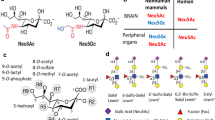Abstract
Recent years witnessed extraordinary rise of interest to sialylation and, specifically, to its role in host–pathogen interactions. Prions or PrPSc are proteinaceous infectious agents that consist of misfolded, aggregated, self-replicating states of a sialoglycoprotein called the prion protein or PrPC. Prions are not conventional pathogens. Nevertheless, due to sialylation of N-linked glycans, prions may use mechanisms similar to those exploited by microbial or viral pathogens in invading a host. Recent studies revealed that sialylation of PrPSc controls prion infectivity, replication rate, and strain-specific glycoform ratios. As such, sialylation is of paramount importance to prion pathogenesis. For assessing sialylation status of PrPSc, we developed reliable protocol that involves two-dimensional electrophoresis followed by Western blot (2D). The current chapter describes the procedure for analysis of sialylation status of PrPSc from various sources including brain, spleen, cultured cells, or Protein Misfolding Cyclic Amplification using 2D.
Access this chapter
Tax calculation will be finalised at checkout
Purchases are for personal use only
Similar content being viewed by others
References
Varki A (2008) Sialic acids in human health and disease. Trends Mol Med 14(8):351–360
Varki A (2010) Uniquely human evolution of sialic acid genetics and biology. Proc Natl Acad Sci U S A 107 (Supplement_2):8939–8946
Prusiner SB (1982) Novel proteinaceous infectious particles cause scrapie. Science 216(4542):136–144
Legname G, Baskakov IV, Nguyen HOB, Riesner D, Cohen FE, DeArmond SJ, Prusiner SB (2004) Synthetic mammalian prions. Science 305(5684):673–676
Katorcha E, Makarava N, Savtchenko R, D’Azzo A, Baskakov IV (2014) Sialylation of prion protein controls the rate of prion amplification, the cross-species barrier, the ratio of PrPSc glycoform and prion infectivity. PLoS Pathog 10(9):e1004366
Srivastava S, Makarava N, Katorcha E, Savtchenko R, Brossmer R, Baskakov IV (2015) Post-conversion sialylation of prions in lymphoid tissues. Proc Natl Acad Sci U S A 112(48):E6654–E6662
Katorcha E, Makarava N, Savtchenko R, Baskakov IV (2015) Sialylation of the prion protein glycans controls prion replication rate and glycoform ratio. Sci Rep 5(1):16912
Makarava N, Savtchenko R, Baskakov IV (2015) Two alternative pathways for generating transmissible prion disease de novo. Acta Neuropathol Commun 3(1):69–13
Makarava N, Savtchenko R, Baskakov IV (2013) Selective amplification of classical and atypical prions using modified protein misfolding cyclic amplification. J Biol Chem 288(1):33–41
Bolton DC, Meyer RK, Prusiner SB (1985) Scrapie PrP 27-30 is a sialoglycoprotein. J Virol 53(2):596–606
Turk E, Teplow DB, Hood LE, Prusiner SB (1988) Purification and properties of the cellular and scrapie hamster prion proteins. Eur J Biochem 176(1):21–30
Endo T, Groth D, Prusiner SB, Kobata A (1989) Diversity of oligosaccharide structures linked to asparagines of the scrapie prion protein. Biochemistry 28(21):8380–8388
Stimson E, Hope J, Chong A, Burlingame AL (1999) Site-specific characterization of the N-linked glycans of murine prion protein by high-performance liquid chromatography/electrospray mass spectrometry and exoglycosidase digestions. Biochemistry 38(15):4885–4895
Stahl N, Baldwin MA, Teplow DB, Hood L, Gibson BW, Burlingame AL, Prusiner SB (1993) Structural studies of the scrapie prion protein using mass spectrometry and amino acid sequencing. Biochemistry 32(8):1991–2002
Rudd PM, Endo T, Colominas C, Groth D, Wheeler SF, Harvey DJ, Wormald MR, Serban H, Prusiner SB, Kobata A et al (1999) Glycosylation differences between the normal and pathogenic prion protein isoforms. Proc Natl Acad Sci U S A 96(23):13044–13049
Stahl N, Baldwin MA, Hecker R, Pan KM, Burlingame AL, Prusiner SB (1992) Glycosylinositol phospholipid anchors of the scrapie and cellular prion proteins contain sialic acid. Biochemistry 31(21):5043–5053
Katorcha E, Klimova N, Makarava N, Savtchenko R, Pan X, Annunziata I, Takahashi K, Miyagi T, Pshezhetsky AV, D’Azzo A et al (2015) Knocking out of cellular neuraminidases Neu1, Neu3 or Neu4 does not affect sialylation status of the prion protein. PLoS One 10(11):e0143218
Makarava N, Kovacs GG, Savtchenko R, Alexeeva I, Budka H, Rohwer RG, Baskakov IV (2012) Stabilization of a prion strain of synthetic origin requires multiple serial passages. J Biol Chem 287(36):30205–30214
Gonzalez-Montalban N, Makarava N, Ostapchenko VG, Savtchenko R, Alexeeva I, Rohwer RG, Baskakov IV (2011) Highly efficient protein misfolding cyclic amplification. PLoS Pathog 7(2):e1001277
Acknowledgments
This work was supported by the National Institute of Health grant R01 NS045585.
Author information
Authors and Affiliations
Corresponding author
Editor information
Editors and Affiliations
Rights and permissions
Copyright information
© 2017 Springer Science+Business Media LLC
About this protocol
Cite this protocol
Katorcha, E., Baskakov, I.V. (2017). Analysis of Charge Isoforms of the Scrapie Prion Protein Using Two-Dimensional Electrophoresis. In: Liberski, P. (eds) Prion Diseases. Neuromethods, vol 129. Humana Press, New York, NY. https://doi.org/10.1007/978-1-4939-7211-1_11
Download citation
DOI: https://doi.org/10.1007/978-1-4939-7211-1_11
Published:
Publisher Name: Humana Press, New York, NY
Print ISBN: 978-1-4939-7209-8
Online ISBN: 978-1-4939-7211-1
eBook Packages: Springer Protocols




